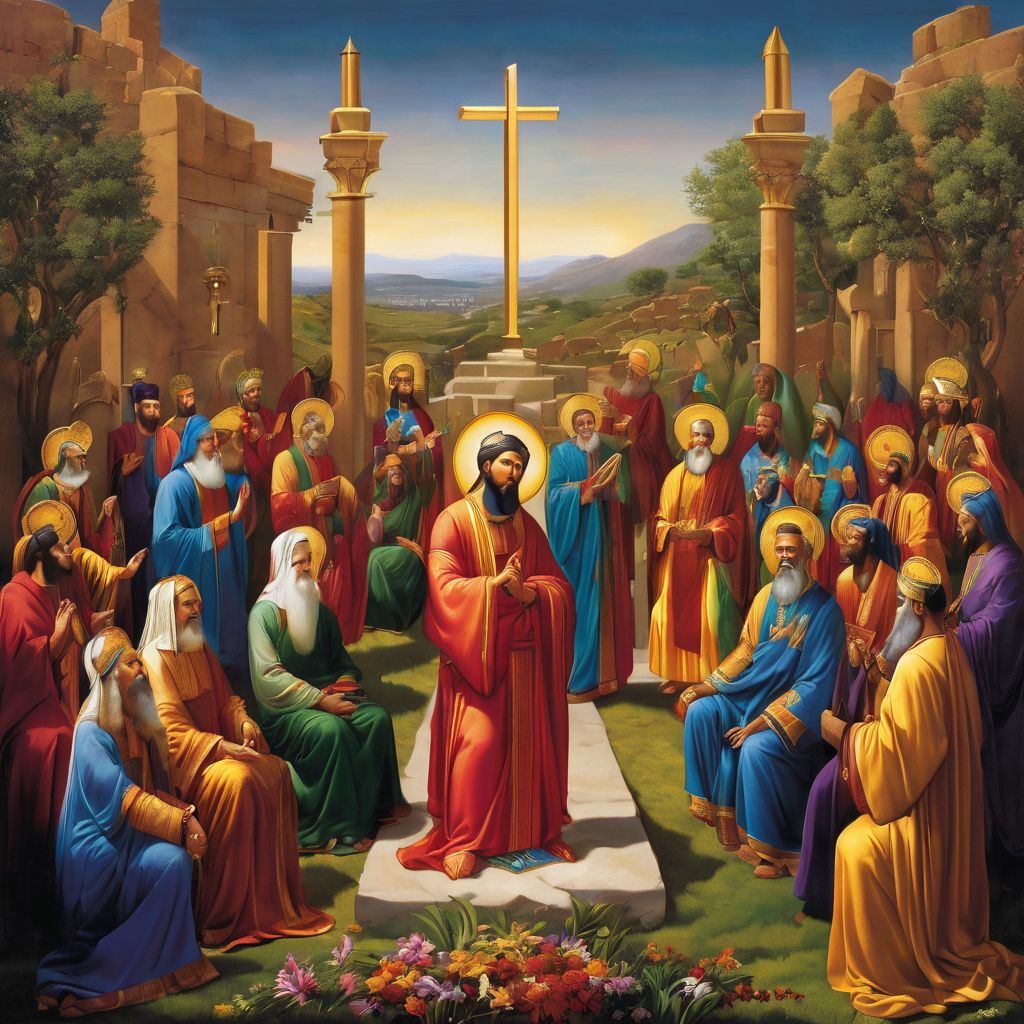Overview of Numbers 15 in the Old Testament
Numbers 15 forms an integral part of the historical narrative in the Old Testament, specifically within the Pentateuch, also known as the Torah. As a foundational text in the biblical canon, Numbers 15 provides essential context for understanding its prophetic, symbolic, and messianic connections to Jesus and the gospel. This historical context is crucial in unraveling the profound significance of Numbers 15 and its implications for biblical theology and the overarching narrative of redemption.
For instance, the Pillar of Cloud and Fire, which guided the Israelites during their wilderness journey, serves as a prominent symbol in Numbers 15. This pillar not only provided physical guidance but also held deep symbolic meaning, representing God’s presence and mission for His people. Understanding the symbolism of the Pillar of Cloud and Fire in Numbers 15 is essential for comprehending its connection to Jesus and the gospel, as it serves as a prefiguration of Christ and His role as the ultimate guide and source of divine direction for believers.
Moreover, Numbers 15 contains prophetic references that align with Jesus as the fulfillment of Old Testament prophecies. These references are intricately woven into specific verses and events, offering insights into the continuity of God’s redemptive plan throughout the biblical narrative. By exploring the historical context and the prophetic references in Numbers 15, we gain a deeper understanding of its significance in relation to Jesus and the gospel, thereby enriching our theological comprehension of the Old Testament text.
In essence, the overview of Numbers 15 in the Old Testament sets the stage for delving into its prophetic, symbolic, and messianic connections to Jesus and the gospel, offering a comprehensive framework for exploring the theological depth of this foundational text.
Historical Context of Numbers 15
The historical context of Numbers 15 is pivotal in unraveling the significance of its prophetic, symbolic, and messianic connections to Jesus and the gospel. One of the most notable symbols within this context is the Pillar of Cloud and Fire, which played a crucial role in guiding the Israelites during their wilderness journey. This pillar signified God’s presence and provided divine direction, serving as a tangible representation of God’s command and mission for His people.
Understanding the symbolism of the Pillar of Cloud and Fire in Numbers 15 is essential for comprehending its connection to Jesus and the gospel. The pillar represents Christ and God’s presence, underscoring the divine guidance and protection offered through Jesus. This historical context serves as a foundation for exploring the prophetic and symbolic references in Numbers 15 that ultimately converge towards Jesus and His redemptive mission.
Furthermore, the historical context of Numbers 15 sheds light on the divine guidance and wisdom imparted to the Israelites through the Pillar of Cloud and Fire. Just as the Israelites were instructed to stay as long as God wanted and set out when God wanted them to go, believers are called to discern and follow God’s leading through the wisdom and guidance provided by Jesus. This parallel underscores the continuity of God’s guidance throughout history and its ultimate fulfillment in the person of Jesus Christ.
The historical context of Numbers 15 not only provides a backdrop for understanding its prophetic and symbolic elements but also offers a glimpse into the divine guidance and wisdom that find their ultimate fulfillment in Jesus and His redemptive work.
#Numbers15Connections #BiblicalNumerology #MessianicSignificance #SymbolicForeshadowing #RedemptiveNarrative #JesusInNumbers #GospelConnections #BiblicalSymbols #DivineForetelling #PropheticPatterns #MessianicProphecies #BiblicalSignificanceOfNumbers #NumericalSymbolism#OldTestamentTypology #JesusAsFulfillment
Prophetic References in Numbers 15
When examining the prophetic references in Numbers 15, we find significant connections to Jesus and the fulfillment of Old Testament prophecies. One notable example is the Priestly Benediction in Numbers 6:24-26, which is understood as a prayer for God’s blessings and peace. This prayer not only reflects the divine blessings and peace bestowed upon the Israelites but also foreshadows Jesus’ role as the ultimate source of these spiritual gifts.
Moreover, the sacrificial system and the regulations for offerings in Numbers 15 hold profound prophetic significance in pointing to Jesus as the ultimate sacrifice for the atonement of sin. The various offerings outlined in Numbers 15, such as the burnt offering, grain offering, drink offering, and sin offering, symbolize different aspects of Jesus’ redemptive work on the cross. For instance, the sin offering prefigures Jesus’ sacrificial death, providing atonement and reconciliation for humanity.
Additionally, the narrative of the bronze serpent in Numbers 21:4-9 serves as a prophetic reference to Jesus, as Jesus himself alludes to this event in John 3:14-15, stating, “Just as Moses lifted up the snake in the wilderness, so the Son of Man must be lifted up, that everyone who believes may have eternal life in him.” This direct parallel between the bronze serpent and the redemptive work of Jesus underscores the prophetic nature of Numbers 15, pointing to Christ as the ultimate source of salvation and healing for all who believe in him.
Furthermore, the research source [2] highlights the messianic interpretation of Genesis 3:15, which is considered the first proclamation of the gospel in the Old Testament. This proclamation serves as a foundational prophecy that finds its fulfillment in Jesus, emphasizing the continuity of messianic promises throughout the biblical narrative. By examining these prophetic references and their connection to Jesus, we gain a deeper appreciation for the cohesive and interconnected nature of God’s plan for redemption across the Old and New Testaments.
In summary, Numbers 15 contains profound prophetic references that intricately connect to Jesus and his role as the fulfillment of Old Testament prophecies. From the Priestly Benediction to the sacrificial system and the narrative of the bronze serpent, these prophetic elements in Numbers 15 provide a rich tapestry of symbolism that ultimately converges towards the redemptive work of Jesus Christ.
Symbolic Elements in Numbers 15
The symbolic elements in Numbers 15 serve as powerful foreshadowing of Jesus and carry deep significance in relation to his identity and mission. One of the most prominent symbolic elements is the Pillar of Cloud and Fire, which guided the Israelites in their wilderness journey. This pillar not only signified God’s presence but also represented Jesus, emphasizing the divine guidance and protection offered through him. The imagery of the pillar as a guiding light for the Israelites parallels Jesus’ role as the light of the world, guiding and illuminating the path for believers.
Furthermore, the sacrificial system outlined in Numbers 15 also carries symbolic weight in connection to Jesus. The sacrificial system points to the ultimate sacrifice of Jesus on the cross for the atonement of sins. The various offerings and their specific purposes symbolize different aspects of Jesus’ redemptive work, underscoring his role as the Lamb of God who takes away the sins of the world. By exploring the symbolic elements in the sacrificial system, we gain a deeper understanding of Jesus’ role as the ultimate atoning sacrifice, fulfilling the divine requirements for reconciliation and salvation.
Moreover, the instructions for the tassels on the garments in Numbers 15:37-41 hold symbolic significance in relation to Jesus. These tassels served as a reminder for the Israelites to keep and remember God’s commandments. In a similar vein, Jesus emphasized the importance of obeying God’s commandments and loving one another, encapsulating the essence of the law and its fulfillment in his teachings. By examining the symbolism of the tassels, we uncover a profound connection to Jesus’ teachings and the enduring relevance of God’s commandments in the life of believers.
Additionally, the research sourceprovides insights into the symbolism of the Tabernacle in Numbers, representing sacredness and various facets of Jesus through its diverse items and functions. The role of the high priest, sacrifices, and salvation by faith all find their symbolic representations within the Tabernacle, offering a comprehensive tapestry of imagery that points to the person and work of Jesus Christ. By delving into these symbolic elements, we gain a deeper appreciation for the rich theological significance of Numbers 15 and its profound connections to Jesus and the gospel.
In essence, the symbolic elements in Numbers 15 are not only rich in their foreshadowing of Jesus but also serve as profound reminders of his redemptive work, sacrificial atonement, and the importance of obedience to God’s commandments in the life of believers.
Messianic Significance of Numbers 15
Numbers 15 holds profound messianic significance, as it contains prophetic references that align with Jesus as the fulfillment of Old Testament prophecies. One significant aspect is the sacrificial system outlined in Numbers 15, which foreshadows the ultimate sacrifice of Jesus Christ on the cross for the redemption of humanity. The specific instructions for offering sacrifices for unintentional sins and the atonement for the entire community in Numbers 15:22-29 symbolize the future atonement brought by Jesus, who is described as the “Lamb of God, who takes away the sin of the world” in the New Testament. This connection between the sacrificial system in Numbers 15 and Jesus as the ultimate sacrificial Lamb is a powerful demonstration of the messianic significance embedded in the text.
Furthermore, the narrative of Numbers 15 also points towards the messianic role of Jesus as the High Priest. The mention of the responsibilities of the high priest in mediating between the people and God, particularly in matters of unintentional sins in Numbers 15:25-28, echoes the role of Jesus as the ultimate High Priest who intercedes for believers before God. The epistle to the Hebrews in the New Testament extensively elaborates on Jesus’ high priesthood, drawing parallels with the priestly functions outlined in the Old Testament, thus affirming the messianic significance of the priestly themes in Numbers 15.
Moreover, the narrative of Numbers 15 also alludes to the messianic promise of a coming prophet who would speak the word of God to the people. This promise finds its fulfillment in Jesus Christ, who is not only the ultimate Prophet but also the Word made flesh, as articulated in the New Testament. The convergence of these prophetic references towards Jesus illustrates the cohesive and interconnected nature of the biblical narrative, underscoring the messianic significance of Numbers 15 and its profound relevance in relation to Jesus as the Messiah.
Additionally, the research source provides valuable insights into the messianic significance of the names mentioned in the first genealogy in Numbers 1, speaking directly to Jesus and his role in the divine narrative. The formation and positions of the tribes of Israel in Numbers 2 also carry symbolic weight that converges towards Jesus, reflecting the symbol of redemption and pointing to Jesus’ role as the ultimate redeemer. By incorporating these insights, we gain a more comprehensive understanding of the messianic significance of Numbers 15 and its profound implications for biblical theology.
In summary, the messianic significance of Numbers 15 is deeply rooted in its prophetic and symbolic elements, offering profound insights into the role of Jesus as the fulfillment of Old Testament prophecies. By unraveling these messianic connections, we gain a deeper appreciation for the cohesive narrative of redemption that finds its ultimate fulfillment in the person and work of Jesus Christ.
Gospel Connection to Numbers 15
The events and themes in Numbers 15 are intricately connected to the core message of the gospel. Understanding the prophetic and symbolic elements in Numbers 15 enriches the comprehension of Jesus’ role in fulfilling the divine plan for salvation.
The significance of the sacrificial system and the laws outlined in Numbers 15 finds its ultimate fulfillment in the person and work of Jesus Christ. For instance, the regulations regarding unintentional sin offerings in Numbers 15 foreshadow Jesus as the ultimate atoning sacrifice for the sins of humanity. The gospel message emphasizes how Jesus, as the Lamb of God, fulfills and surpasses the sacrificial system in Numbers 15, offering eternal redemption through His own blood. This connection highlights the continuity of God’s plan for salvation from the Old Testament to the New Testament, emphasizing Jesus as the ultimate fulfillment of the law and the prophets.
Furthermore, the narrative of Numbers 15 also sheds light on the concept of grace and obedience in the gospel. The grace of God in providing a means of atonement for unintentional sins in Numbers 15 reflects the overarching theme of God’s grace in the gospel. This grace finds its ultimate expression in the sacrificial death and resurrection of Jesus, providing forgiveness and reconciliation for all who believe in Him. Additionally, the call for obedience to God’s commandments in Numbers 15 finds its counterpart in the gospel message, where Jesus calls believers to obey His teachings out of love and gratitude for the grace they have received. These parallels between Numbers 15 and the gospel serve to underscore the continuity and coherence of God’s redemptive plan throughout history.
Moreover, the research source provides insights into the messianic interpretation of Genesis 3:15, considered the first proclamation of the gospel in the Old Testament. This proclamation serves as a foundational prophecy that finds its fulfillment in Jesus, emphasizing the continuity of messianic promises throughout the biblical narrative. By examining these gospel connections, we gain a deeper understanding of the coherence and continuity of God’s redemptive plan from the Old Testament to the New Testament.
In essence, the gospel connection to Numbers 15 underscores the profound coherence and continuity of God’s redemptive plan, culminating in the person and work of Jesus Christ. By exploring these connections, we gain a deeper appreciation for the rich tapestry of symbolism and prophetic references that converge towards the gospel message in Numbers 15.
Jesus as the Pillar of Cloud and Fire
The symbolism of Jesus as the Pillar of Cloud and Fire in Numbers 15 is a profound representation of God’s presence and mission. Just as the Pillar of Cloud and Fire guided the Israelites in their wilderness journey, Jesus serves as the ultimate guide for believers, providing divine direction and leading them in their spiritual journey. This symbolic connection underscores Jesus’ role as the embodiment of God’s presence and the ultimate source of divine guidance and protection for believers.
Furthermore, the Pillar of Cloud and Fire is a picture of Christ, representing God’s command and mission for the Israelites. Similarly, Jesus fulfills the divine mission of salvation and redemption for humanity, as prophesied in the Old Testament and fulfilled in the New Testament. This parallel underscores the messianic significance of Jesus and his role as the ultimate fulfillment of Old Testament prophecies, including those found in Numbers 15.
The importance of discerning God’s leading through wisdom, as symbolized by the Pillar of Cloud and Fire, resonates with the guidance and wisdom that Jesus provides to his followers. Just as the Israelites were instructed to stay as long as God wanted and set out when God wanted them to go, Christians are called to discern and follow God’s leading through the wisdom and guidance provided by Jesus. This connection further solidifies Jesus’ role as the ultimate source of divine wisdom and guidance for believers, aligning with the symbolism of the Pillar of Cloud and Fire in Numbers 15.
Additionally, the research source provides insights into the Pillar of Cloud and Fire as a guiding symbol for the Israelites, representing God’s presence and serving as a tangible reminder of God’s command and mission. This symbolism finds its ultimate fulfillment in Jesus, who embodies the divine guidance and protection offered through the Pillar of Cloud and Fire. By incorporating these insights, we gain a more comprehensive understanding of Jesus as the ultimate guide and source of divine direction for believers, in alignment with the symbolism of the Pillar of Cloud and Fire in Numbers 15.
In essence, the symbolism of Jesus as the Pillar of Cloud and Fire in Numbers 15 offers a profound representation of God’s presence and guidance, highlighting Jesus’ role as the ultimate source of divine direction and protection for believers.
Numbers 15 Converging Towards Jesus
When examining Numbers 15 through a biblical lens, it becomes evident that the narrative converges towards Jesus, offering prophetic, symbolic, and messianic connections. One significant aspect that points to Jesus is the genealogies mentioned in Numbers 1. The names listed in the genealogy hold deep significance, as they speak to the lineage that ultimately leads to Jesus. This connection underscores the continuity of God’s plan throughout history, culminating in the arrival of Jesus as the fulfillment of the Old Testament prophecies.
Furthermore, the positioning of the tribes of Israel in Numbers 2 also carries symbolic weight that converges towards Jesus. The specific arrangement of the tribes reflects the symbol of redemption, foreshadowing Jesus’ role as the ultimate redeemer. This alignment serves as a prefiguration of Jesus’ redemptive mission, emphasizing the interconnectedness of the Old Testament with the person and work of Christ. These symbolic elements in the positioning of the tribes serve to reinforce the overarching narrative of salvation that finds its fulfillment in Jesus.
Additionally, the research source provides valuable insights into the convergence of Numbers 15 towards Jesus, highlighting the formation and positions of the tribes of Israel and their symbolic representation of redemption. The Tabernacle in Numbers also carries profound symbolism, representing sacredness and various facets of Jesus through its diverse items and functions. By delving into these converging elements, we gain a deeper appreciation for the rich theological significance of Numbers 15 and its profound connections to Jesus and the gospel.
In essence, Numbers 15 converges towards Jesus through its prophetic, symbolic, and messianic elements, offering profound insights into the continuity and fulfillment of Old Testament prophecies in the person and work of Jesus Christ.
Symbolism of the Tabernacle in Numbers
The Tabernacle in Numbers is a rich source of symbolism, representing sacredness and various facets of Jesus through its diverse items and functions. For instance, the role of the high priest, as depicted in the Tabernacle, mirrors Jesus as the ultimate high priest who mediates between humanity and God. The significance of the sacrifices offered in the Tabernacle points to the ultimate sacrifice of Jesus, who offered himself for the redemption of humanity. The concept of salvation by faith is also symbolized through the Tabernacle, highlighting the centrality of faith in Jesus for salvation.
Moreover, the layout and specific elements of the Tabernacle, such as the Ark of the Covenant, the altar, and the lampstand, all hold symbolic meanings that connect to Jesus and his redemptive work. The Ark of the Covenant, as the dwelling place of God, represents the presence of God among his people, foreshadowing Jesus as the embodiment of God’s presence on earth. The altar symbolizes the atoning work of Jesus, while the lampstand signifies Jesus as the light of the world, bringing illumination and guidance to humanity.
Furthermore, the research source provides insights into the symbolism of the Tabernacle in Numbers, representing various facets of Jesus and his redemptive work. The Tabernacle serves as a profound tapestry of symbolism, intricately weaving together various elements that point to the person and work of Jesus Christ. Each detail and function within the Tabernacle contributes to the overarching narrative of God’s redemptive plan, culminating in the fulfillment found in Jesus Christ.
In essence, the Tabernacle in Numbers serves as a profound representation of Jesus and his redemptive mission, offering a comprehensive tapestry of symbolism that points to the person and work of Jesus Christ.
Conclusion
In conclusion, Numbers 15, as a historical narrative in the Old Testament, plays a significant role in unveiling profound prophetic, symbolic, and messianic connections to Jesus and the gospel. These connections enrich our understanding of Jesus’ role in the divine narrative, offering insights



